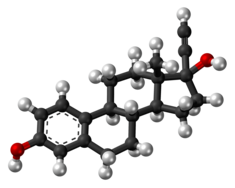|
에티닐에스트라다이올
에티닐에스트라다이올

|

|
| 체계적 명칭 (IUPAC 명명법)
|
| (8R,9S,13S,14S,17R)-17-ethynyl-13-methyl-7,8,9,11,12,14,15,16-octahydro-6H-cyclopenta[a]phenanthrene-3,17-diol
|
| 식별 정보
|
| CAS 등록번호
|
57-63-6
|
| ATC 코드
|
G03CA01 L02AA03
|
| PubChem
|
5991
|
| 드러그뱅크
|
DB00977
|
| ChemSpider
|
5770
|
| 화학적 성질
|
| 화학식
|
C20H24O2
|
| 분자량
|
?
|
| 유의어
|
ethynylestradiol; ethinyl estradiol; ethinyl oestradiol; EE; EE2; 17α-ethynylestradiol; 17α-ethynylestra-1,3,5(10)-triene-3,17β-diol; NSC-10973ref name="Elks2014">Elks J (2014년 11월 14일). 《The Dictionary of Drugs: Chemical Data: Chemical Data, Structures and Bibliographies》. Springer. 522–쪽. ISBN 978-1-4757-2085-3. </ref>
|
| 물리적 성질
|
| 녹는점
|
182–184 °C (360–363 °F)
|
| 약동학 정보
|
| 생체적합성
|
38–48%[1][2][3]
|
| 단백질 결합
|
97–98% (알부민에 결합;[4]SHBG에 결합하지 않음)[5]
|
| 동등생물의약품
|
?
|
| 약물 대사
|
간 (주로 CYP3A4)[6]
|
| 생물학적 반감기
|
7–36 hours[6][1][7][8]
|
| 배출
|
대변: 62%[7]
소변: 38%[7]
|
| 처방 주의사항
|
| 허가 정보
|
유럽 의약청:바로가기
|
| 임부투여안전성
|
X (미국)
|
| 법적 상태
|
- In general: ℞ (Prescription only)
|
| 투여 방법
|
• 경구 투여 (알약)
• 피부경유 (피임 패치)
• 질내 투여 (질내 고리)
|
에티닐에스트라다이올(영어: ethinylestradiol, EE)은 프로게스틴과 함께 피임약에 널리 사용되는 에스트로젠 약물이다.[9][10] 17α-에티닐에스트라다이올(영어: 17α-ethinylestradiol), 17-R-에티닐에스트라다이올(영어: 17-R-ethinylestradiol)이라고도 한다. 과거에 에티닐에스트라다이올은 갱년기 증상, 부인과 질환 및 특정 호르몬 민감성 암의 치료와 같은 다양한 적응증에 널리 사용되었다. 일반적으로 경구 투여하지만 패치 및 질내고리로 사용된다.[9][11]
같이 보기
각주
- ↑ 가 나 Goldzieher JW, Brody SA (December 1990). “Pharmacokinetics of ethinyl estradiol and mestranol”. 《American Journal of Obstetrics and Gynecology》 163 (6 Pt 2): 2114–2119. doi:10.1016/0002-9378(90)90550-Q. PMID 2256522.
- ↑ Fruzzetti F, Trémollieres F, Bitzer J (May 2012). “An overview of the development of combined oral contraceptives containing estradiol: focus on estradiol valerate/dienogest”. 《Gynecological Endocrinology》 28 (5): 400–408. doi:10.3109/09513590.2012.662547. PMC 3399636. PMID 22468839.
- ↑ Fotherby K (August 1996). “Bioavailability of orally administered sex steroids used in oral contraception and hormone replacement therapy”. 《Contraception》 54 (2): 59–69. doi:10.1016/0010-7824(96)00136-9. PMID 8842581.
- ↑ Facts and Comparisons (Firm); Ovid Technologies, Inc (2005). 《Drug Facts and Comparisons 2005: Pocket Version》. Facts and Comparisons. 121쪽. ISBN 978-1-57439-179-4.
- ↑ Micromedex (2003년 1월 1일). 《USP DI 2003: Drug Information for Healthcare Professionals》. Thomson Micromedex. 1253, 1258, 1266쪽. ISBN 978-1-56363-429-1.
- ↑ 가 나 Hughes CL, Waters MD (2016년 3월 23일). 《Translational Toxicology: Defining a New Therapeutic Discipline》. Humana Press. 73–쪽. ISBN 978-3-319-27449-2.
- ↑ 가 나 다 Stanczyk FZ, Archer DF, Bhavnani BR (June 2013). “Ethinyl estradiol and 17β-estradiol in combined oral contraceptives: pharmacokinetics, pharmacodynamics and risk assessment”. 《Contraception》 87 (6): 706–727. doi:10.1016/j.contraception.2012.12.011. PMID 23375353.
- ↑ Shellenberger TE (1986). 〈Pharmacology of estrogens〉. 《The Climacteric in Perspective》. 393–410쪽. doi:10.1007/978-94-009-4145-8_36. ISBN 978-94-010-8339-3.
Ethinyl estradiol is a synthetic and comparatively potent estrogen. As a result of the alkylation in 17-C position it is not a substrate for 17β dehydrogenase, an enzyme which transforms natural estradiol-17β to the less potent estrone in target organs.
- ↑ 가 나 Kuhl H (August 2005). “Pharmacology of estrogens and progestogens: influence of different routes of administration”. 《Climacteric》 8 (Suppl 1): 3–63. doi:10.1080/13697130500148875. PMID 16112947. S2CID 24616324.
- ↑ Oettel M, Schillinger E (2012년 12월 6일). 《Estrogens and Antiestrogens II: Pharmacology and Clinical Application of Estrogens and Antiestrogen》. Springer Science & Business Media. 4,10,15,165,247–248,276–291,363–408,424,514,540,543,581쪽. ISBN 978-3-642-60107-1.
The binding affinity of EE2 for the estrogen receptor is similar to that of estradiol. [...] During daily intake, the EE2 levels increase up to a steady state which is reached after about 1 week.
- ↑ “Drugs@FDA: FDA Approved Drug Products”. United States Food and Drug Administration. 2016년 12월 22일에 확인함.
더 읽을거리
- Oettel M, Schillinger E (2012년 12월 6일). 《Estrogens and Antiestrogens II: Pharmacology and Clinical Application of Estrogens and Antiestrogen》. Springer Science & Business Media. 4,10,15,165,247–248,276–291,363–408,424,514,540,543,581쪽. ISBN 978-3-642-60107-1.
- Kuhl H (August 2005). “Pharmacology of estrogens and progestogens: influence of different routes of administration”. 《Climacteric》 8 (Suppl 1): 3–63. doi:10.1080/13697130500148875. PMID 16112947. S2CID 24616324.
- Stanczyk FZ, Archer DF, Bhavnani BR (June 2013). “Ethinyl estradiol and 17β-estradiol in combined oral contraceptives: pharmacokinetics, pharmacodynamics and risk assessment”. 《Contraception》 87 (6): 706–727. doi:10.1016/j.contraception.2012.12.011. PMID 23375353.
- Mattison DR, Karyakina N, Goodman M, LaKind JS (September 2014). “Pharmaco- and toxicokinetics of selected exogenous and endogenous estrogens: a review of the data and identification of knowledge gaps”. 《Critical Reviews in Toxicology》 44 (8): 696–724. doi:10.3109/10408444.2014.930813. PMID 25099693. S2CID 11212469.
|
|